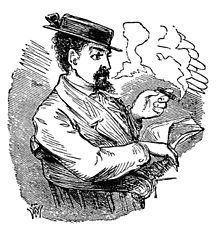 | ||
Full Name Truman W. Williams Books The Illustrated Adventures of Tom Sawyer Similar E W Kemble, Otto Ubbelohde, George Roux, John Tenniel, Bertall | ||
Truman W. "True" Williams (March 22, 1839 – November 23, 1897) was an American artist known as the most prolific illustrator to Mark Twain's books and novels. He drew all illustrations to the first edition of The Adventures of Tom Sawyer (1876) and was thus the first to illustrate such characters as Tom Sawyer and Huckleberry Finn. He was also sole illustrator of Twain's Sketches, New and Old and primary illustrator of Roughing It and The Innocents Abroad. Working with a number of publishers he also illustrated works by writers Bill Nye, George W. Peck, Joaquin Miller, and others. His style in Tom Sawyer influenced E. W. Kemble's work in his illustrations to Adventures of Huckleberry Finn (1884).
Born in Allegany County, New York, Williams grew up in Watertown. His father died when he was 10, and Williams moved to Illinois and served in a volunteer infantry unit in the Civil War, from December 21, 1863, to October 9, 1865, during which he worked under General William T. Sherman as a topographical engineer. He began illustrating professionally in the late 1860s, working largely with the American Publishing Company. In addition to his work with Twain, he illustrated an autobiography of P. T. Barnum and works by the likes of humorists George Wilbur Peck and Bill Nye, and his work appeared in Harper's Weekly and Harper's Bazar.
Literary critic Michael Patrick Hearn describes Williams as "an indifferent draftsman, his pictures varying from coarse to the highly sentimental". Regarding his work in Tom Sawyer, Warren Chappell writes "it is evident that Williams did not always take care in reading the text. As the first man to do the whitewashing scene, he carelessly used a rail fence instead of the board fence which is described." Williams was also known to incorporate subtle humor into his illustrations for Tom Sawyer: he placed his own name on a gravestone in one scene, and in another it has been suggested he deliberately altered the lettering on a sign reading "The pen is mightier than the sword" to appear "the penis mightier than the sword", a pun which Twain himself used many years later.
Williams married Carrie M. Heath April 19, 1884. She died on July 25, 1885, from tuberculosis and premature childbirth, and their premature son died shortly after. On July 27, 1886 Williams married Rose Heath, the younger sister of Carrie. They divorced in 1892 due to True's alcoholism, which included being drunk for a week or more. He died in Chicago, Illinois, from internal bleeding due to an aortic aneurysm on November 23, 1897, at the age of 58.
Works
Williams' work appears in six works by Mark Twain:
Own works:
Works by other authors in which Williams was sole or contributing artist include:
